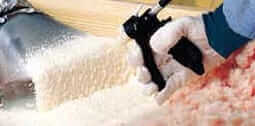AWF Blog
One Component Foam “Insulation” Vs. Two Component Foam Insulation: Why is it different? Where can it be used? And why it matters.
Posted by Carmen T. on Jan 22nd 2024

When taking the time to research your upcoming insulating or sealing project, you'll come across a large variety of products. In this category, you will encounter two materials: Foam Sealants, a one-component foam claimed to work as a one-component insulation, and Spray Foam Insulation, which is a two-component foam.
The one-component foam typically presents in a smaller PRO can, ranging from 18-27 oz., requiring a foam applicator, whereas a two-component foam is available in kits composed of two canisters or cylinders that range from 20-60 lbs. each. While both product forms are excellent, their applications are drastically different. To better understand the application of these products, we must first understand why they are different; the key factor in this difference is how these products were created.
One-component foam sealants are pre-reacted foams, meaning the foam is "ready to use" out of the can. Before creating the foam, specific chemicals are combined and allowed to undergo a controlled reaction. After the pre-reaction, the material is processed further to make the foam; this typically involves adding ingredients, such as blowing agents, and then applying the final product in conditions that allow it to expand and solidify into a foam structure.
Two-component foam insulation is a Reacted Foam, a foam material created through a chemical reaction. In simple terms, two chemicals, Iso and Polyol (typically labeled A & B), are mixed. Once combined, they undergo a reaction where it expands and cures, creating the foam.
With this, we lead into the foam curing process. The cure depth refers to how deep the foam cures or hardens from its exposed surface. This factor is significant for your application, as it determines the foam's final properties, such as density, hardness, and other mechanical characteristics.
For one-component foam, the applications are limited and no more than an inch at a time. This is because these sealants cure with the moisture in the air, therefore overapplying these products can lead to a foam that never solidifies and remains tacky. In addition, the product's higher expansion causes the foam to have lower insulation properties. Because of these restrictions, the product's overall performance and appropriateness make these sealants unsuitable for a wall cavity application between studs if you intend to insulate. These products are more suitable for smaller cracks and voids.
The two-component foam formulations have a design that allows the product to cure consistently throughout the application. This advantage exists because the chemicals start mixing at the nozzle, allowing the curing process to begin as it is dispensed. This will enable you to achieve greater depth/thickness, providing a higher R-value, and enhancing insulating properties for your project. These factors make two-component foams more suitable for large projects, especially in a wall cavity where insulating performance is critical.
Key Differences:
Components: The main difference lies in the number of components. One-component foam comes ready to use in a can, while two-component foam has two separate components that require mixing.
Application Size: One-component Foam is suitable for smaller projects, while two-component foam is applied in larger-scale applications.
Insulating Properties: One-component foam is not typically tested to determine an R-value as it is not designed for large insulating projects. Two-component foams will be tested to determine an R-value since they are designed for large insulating projects where the R-value is essential.
Convenience vs. Performance: One-component foam is convenient but has application, expansion, and performance limitations. Two-component foam, while requiring mixing, is often chosen for its enhanced insulation properties in large-scale projects as it provides more versatility and control over the expanding process.
It's important to note that both single-component and two-component foams have their applications and strengths. Overall, the product choice is specific to the needs and magnitude of the project. Following the manufacturer's guidelines for your particular foam product is crucial. The information provided here is generalized, and performance can vary depending on the product and application conditions.





